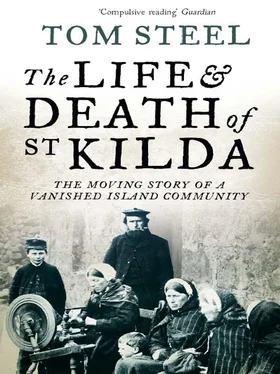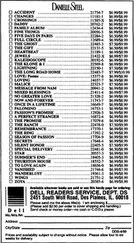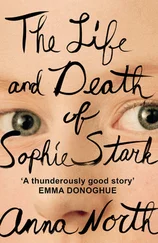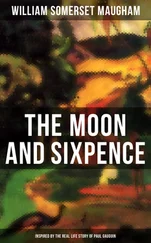Hirta could boast a society that from time immemorial treated women as equal, certainly in terms of the work that had to be done. The peats were carried by the women and children on their backs in old plaids or pieces of canvas. ‘It is astonishing’, wrote Ross, ‘to see the burden even the children from six to nine years of age can take.’ There was little room in the house to store the dry peat, so trips to the hills had to be made regularly. ‘We helped too, young as we were,’ remembers Flora Gillies, only ten years old at the time of the evacuation. ‘I always carried for my grandfather. I don’t know why, but I always seemed to carry it. My Aunt Mary, it was nothing for her to carry a bag on her back. She was very strong.’
The women also looked after the cattle, and cut all the grass required for their feeding during the winter months. Twice a day in the summer months they would make the long walk over to Glean Mor to milk the cows and ewes. The first visit was made at daybreak and they would return to the Glean again at five o’clock in the evening. If necessary they would take a bundle of grass with them on their backs to keep the beasts happy while they were being milked.
All the fetching and carrying on the island was delegated by the men to the women. ‘Goods from Glasgow’, wrote Ross, ‘are carried by the women from the shore to their houses and woe be unto them unless they are ready waiting when the men get the cargo to the shore.’ In the landing of stores, the men were responsible for manning the island boats out to the ship and the transferring of goods from the factor’s smack or the steamer to the rowing boat. On reaching shore, the men would tumble the supplies out of the boat. ‘There being but little room,’ wrote Ross, ‘everything must be removed quickly or the place is blocked up. Such a block happened that day bringing forth a hurricane of yelling from the men but no assistance with it. This is always the case when a thing comes too hard on the men, they poke their hands down to the elbows in their trousers pockets and yell away whereas the poor women almost worry their lives out to avoid this. That day I noticed some of them literally groan under their loads without being offered the slightest sympathy or assistance.’
Occasionally the women had some time to devote to knitting. ‘The stocking’, wrote the schoolmaster Ross, ‘is always carried about her person, ready to be taken whatever situation if she is idle.’ Except for the winter months, however, the women found little time to knit. They were far more busy than the men, for there were always things to be done about the house, and in the summer months they had their part to play in the harvesting of birds. The only work specifically reserved for the men was the grand, heroic task of manning the boats and climbing the cliffs in search of birds.
By the nineteenth century, the St Kildans had little faith in the value of their crofts. From a barrel of potatoes, weighing about two hundredweight, McDiarmid reckoned in 1877 that the islanders would scarcely lift three barrels. Owing to a constant subjection to seaspray, the potatoes that were salvaged were soft and tasted more like yams. Although barley and oats were equally prominent features of the St Kildan diet, the yield was likewise small. Oats were generally sown very thickly, from ten to twelve bushels to every acre of ground, and the return was rarely above three times the quantity sown. The islanders attempted to grow a few cabbages and a few turnips, but on Hirta weeds grew more easily than crops. In season, the whole of the arable land looked more like a bed of marigolds than a provider of grain and vegetables.
Конец ознакомительного фрагмента.
Текст предоставлен ООО «ЛитРес».
Прочитайте эту книгу целиком, купив полную легальную версию на ЛитРес.
Безопасно оплатить книгу можно банковской картой Visa, MasterCard, Maestro, со счета мобильного телефона, с платежного терминала, в салоне МТС или Связной, через PayPal, WebMoney, Яндекс.Деньги, QIWI Кошелек, бонусными картами или другим удобным Вам способом.












